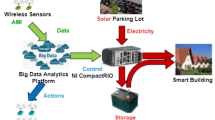Abstract
In this paper recurrent neural networks are used for modelling of the exhaust gas aftertreatment system of a spark-ignition engine including a three-way catalytic converter and oxygen sensors. Different network architectures are compared based on their achieved mean squared error. We find that physically inspired architectures surpass naive architectures built without knowledge of the physical system. The best resulting model is evaluated by giving the quantiles of the absolute error.




Similar content being viewed by others
References
Auckenthaler TS (2005) Modelling and control of three-way catalytic converters
Bailer-Jones CAL, MacKay DJC, Withers PJ (1998) A recurrent neural network for modelling dynamical systems. Netw Comput Neural Syst 9(4):531–547
Bengio Y, Frasconi P, Simard P (1993) The problem of learning long-term dependencies in recurrent networks. In: IEEE International Conference on Neural Networks, pp 1183–1188
Bishop CM (2006) Pattern recognition and machine learning, vol 4. Springer, New York
Chatterjee D, Deutschmann O, Warnatz J (2001) Detailed surface reaction mechanism in a three-way catalyst. Faraday Discuss 119:371–384
Cho K, van Merrienboer B, Bahdanau D, Bengio Y (2014) On the properties of neural machine translation: encoder - decoder approaches. Syntax, semantics and structure in statistical translation, pp 103–111
Cho K, van Merrienboer B, Gulcehre C, Bahdanau D, Bougares F, Schwenk H, Bengio Y (2014) Learning phrase representations using RNN encoder-decoder for statistical machine translation. In: Proceedings of the 2014 conference on empirical methods in natural language processing (EMNLP), pp 1724–1734
Chung J, Gulcehre C, Cho K, Bengio Y (2014) Empirical evaluation of gated recurrent neural networks on sequence modeling. arXiv preprint. arXiv:14123555, pp 1–9
Feßler DK (2010) Modellbasierte On-Board-Diagnoseverfahren fr Drei-Wege-Katalysatoren
Gers FA, Schmidhuber J, Cummins F (2000) Learning to forget: continual prediction with LSTM. Neural Comput 12(10):2451–2471
Graves A, Wayne G, Danihelka I (2014) Neural Turing Machines. arXiv preprint arXiv:14105401
Hochreiter S, Schmidhuber J (1997) Long short-term memory. Neural Comput 9(8):1735–1780
Hornik K, Stinchcombe M, White H (1989) Multilayer feedforward networks are universal approximators. Neural Netw 2(5):359–366
Jozefowicz R, Zaremba W, Sutskever I (2015) An empirical exploration of recurrent network architectures. In: Proceedings of the 32nd international conference on machine learning (ICML-15), pp 2342–2350
Kingma DP, Ba JL (2014) Adam: a method for stochastic optimization. arXiv preprint arXiv:14126980
Kumar P, Makki I, Kerns J, Grigoriadis K, Franchek M, Balakotaiah V (2012) A low-dimensional model for describing the oxygen storage capacity and transient behavior of a three-way catalytic converter. Chem Eng Sci 73:373–387
Pascanu R, Mikolov T, Bengio Y (2013) On the difficulty of training recurrent neural networks. In: International conference on machine learning, vol 28(3). pp 1310–1318
Pontikakis GN, Konstantas GS, Stamatelos AM (2004) Three-way catalytic converter modeling as a modern engineering design tool. J Eng Gas Turbines Power 126(10):906–923
Schrholz K, Brckner D, Gresser M, Abel D (2018) Modeling of the three-way catalytic converter by recurrent neural networks. IFAC-PapersOnLine 51(15):742–747
Welch BL (1947) The generalization of student’s problem when several different population variances are involved. Biometrika 34(1/2):28–35
Yadaiah N, Sowmya G (2006) Neural network based state estimation of dynamical systems. In: The 2006 IEEE international joint conference on neural networks, pp 1042–1049
Yao Y, Rosasco L, Caponnetto A (2005) On early stopping in gradient descent learning. Constr Approx 26(2):289–315
Author information
Authors and Affiliations
Corresponding author
Rights and permissions
About this article
Cite this article
Schürholz, K., Brückner, D. & Abel, D. Modelling the Exhaust Gas Aftertreatment System of a SI Engine Using Artificial Neural Networks. Top Catal 62, 288–295 (2019). https://doi.org/10.1007/s11244-018-1089-9
Published:
Issue Date:
DOI: https://doi.org/10.1007/s11244-018-1089-9




